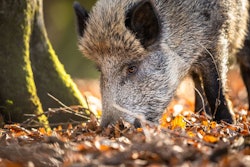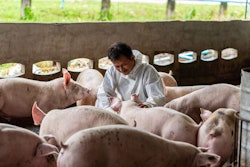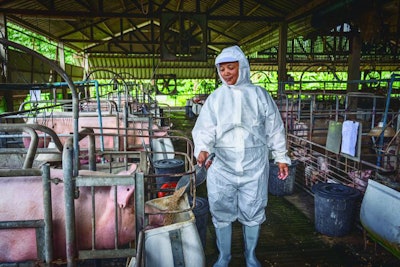
Industry stakeholders discuss ASF prevention and how an outbreak could impact your feed operation.
For nearly five years, pork producers throughout the Eastern hemisphere have been struggling to contain and eradicate African swine fever (ASF) virus in their domestic herds with limited success. To date, the deadly, highly infectious pig disease has not yet reached North America; however, it is very close to its shores, turning up in the Dominican Republic and Haiti, in 2021.
“The emergence of ASF in our hemisphere is a worrying sign,” says Todd Thurman, consultant, SwineTex Consulting Services LLC. “I’ve been more optimistic than many of my colleagues about our ability to keep ASF out of the U.S., but I’ll admit the outbreak so close to our border made it much more likely that we’ll deal with an outbreak at some point.”
With Puerto Rico less than 85 miles from the Dominican Republic, the U.S. swine industry not only faces the risk of the virus hitting the mainland, but as a U.S. territory an outbreak, the U.S. would be required to change its World Organization of Animal Health (OIE) status to an affected country. Because one-third of U.S. pork is exported, this would have serious economic implications to the entire animal protein sector.
“We’re in the midst of a number of trade renegotiations to try to address [this scenario], because a number of our initial trade agreements with many countries have been built with all meats,” explains Dr. Cassie Jones, professor – Department of Animal Sciences & Industry, Kansas State University (KSU), noting that opening trade from one country to another includes multiple types of animal protein in the same agreement. “We’re currently working on making sure that if Puerto Rico goes positive, we potentially could continue to have export capabilities of domestically mainland-produced pork and recognize those control zones to protect trade.”
Government and industry surveillance efforts and COVID-19’s travel reduction likely have slowed its spread, but in the worst-case scenario, an ASF outbreak stateside could cost the U.S. pork industry an estimated US$50 billion, according to an Iowa State University study.
Pork producers, trade associations, government agencies and allied ag industries are focused on prevention, research and having the necessary measures in place for a rapid and effective outbreak response. Here’s a look at the latest on risk factors, preventive measures, stakeholder preparedness and what happens if ASF is detected in the U.S. herd.
Gauging ingredient risks, protecting trade
Today, the U.S. pork and feed industries’ ASF prevention strategy centers around the exclusion of high-risk ingredients from high-risk countries and the utilization of hold times on imported products.
The U.S. swine industry and the Feed Risk Task Force, which includes representatives from the agriculture and feed industry, the Food and Drug Administration (FDA) and U.S. Department of Agriculture (USDA), are working to better understand and reduce the risk of feed imports, but the consideration of restrictions and regulatory action requires a realistic, science-based approach to determine the scope.
“Not all ingredients are created equally. Some ingredients like whole grains or whole oil seeds from a country that has endemic ASF in its wild boar population is more likely to have ASF contamination in it than an amino acid or vitamin from the same country,” Jones notes. “Once we start talking about import restrictions, let’s be careful, because we need to continue to have access for our pork.”
Jones notes that most commodity imports are low risk and/or from countries that do not have ASF present, but as the virus spreads, the U.S. will have an increasing quantity of ingredients being imported from ASF-endemic regions, noting whole grains are the riskiest based on how raw agricultural commodities grains are transported and grown.
To mitigate these risks, a working group of stakeholders from the leading swine integrators have moved toward implementing a best practice program for “collectively uniting as an industry against ASF” and pushing to adopt an industrywide effort,” Jones reports.
Its best practice principles include:
- Excluding use of high-risk imported ingredients
- Holding times and temperature controls for high-risk ingredients that cannot be excluded, such vitamins and amino acids
- Use of thermal processing and feed mitigants during the feed manufacturing process
However, without buy-in and adoption of these measures from all producers and production partners, the entire swine industry is “only as strong as its weakest link.”
“As we move forward, the swine industry is starting to look at other mechanisms to bring along some of their smaller, maybe less sophisticated production partners that historically haven’t had to look at this as a risk-based scenario,” Jones explains.
On a national level, the U.S. Swine Health Improvement Plan (U.S. SHIP), which is modeled after the poultry industry’s National Poultry Improvement Plan (NPIP), “aims to establish a similar platform for safeguarding, improving and representing the health status of swine across participating farm sites, supply chains, states and regions,” which includes addressing the risks associated with disease transmission in feed for a broadly applicable feed biosafety plan and certification program to support “ongoing interstate commerce and a pathway toward the resumption of international trade over the course of a trade-impacting disease response and recovery period.”
Jones explains: “This group is working with all segments of the industry, but one of their primary initiatives is feed biosafety, and believing that a feed biosafety plan is going to be a requirement in order for these pork producers in the future to be part of U.S. SHIP.”
Meanwhile a feed-specific working group is responsible for providing U.S. SHIP recommendations in two areas: best practices for responsible import of feed and ingredients from ASF- and classical swine fever (CSF)-endemic regions, and to develop industry standards for feed biosecurity.
Because this could have major implications for the U.S. feed industry, the Feed Risk Task Force’s involvement aims to provide guidance so the final recommendations make scientific sense and can be implemented broadly across the industry.
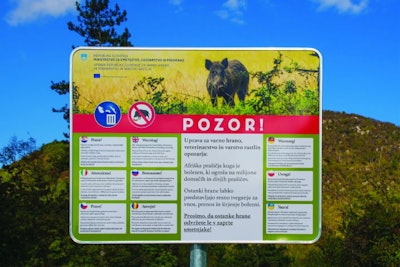 To date, no ASF-affected countries have been able to eradicate the disease. (Dragoncello | iStock.com)
To date, no ASF-affected countries have been able to eradicate the disease. (Dragoncello | iStock.com)Planning, prevention is key
Working under the assumption that it’s not a matter or if, but when, ASF will reach North America, feed producers must continue to be on high alert and diligent with their biosecurity protocols at feed manufacturing and ingredient facilities.
“I think perhaps more concerning – and more threatening – is not that ASF is going to enter as an ingredient, but that there’s potential for ASF movement through the feed supply chain,” Jones says.
According to Jones, ASF has an incubation period of seven to 21 days, meaning that it can take between one to three weeks from the point of infection until the first clinical signs are present in an animal.
“Unfortunately, the way we move feed and ingredients means that deliveries will have been made, back and forth from mills to farms – and back and forth from those mills to the ingredient suppliers – by the time we recognize that ASF has entered,” Jones says.
Here, Jones suggests industry focus on planning and prevention simultaneously.
“We need to be focusing on planning response actions now and hope we never have to use them, but ultimately rely on them to guide decisions and utilization of that plan moving forward,” she says.
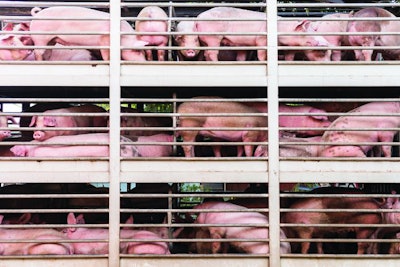 Once ASF contaminates a feed mill or feed delivery truck, decontamination is next to impossible, making transportation the No. 1 threat to virus containment and most likely way it will spread. (Somrerk Kosolwitthayanant | iStock.com)
Once ASF contaminates a feed mill or feed delivery truck, decontamination is next to impossible, making transportation the No. 1 threat to virus containment and most likely way it will spread. (Somrerk Kosolwitthayanant | iStock.com)Response considerations, preparation
Forward-looking preparedness in the face of disease challenges is driving the planning efforts and investments of many feed industry companies.
“I don’t want to be worrying about what we’re going to do the day ASF is here in the U.S.,” says Doug Webel, president and CEO, United Animal Health (UAH), a Sheridan, Indiana-based swine feed, premix and additive supplier. “I want to know exactly what we’re going to do. Let’s make sure we can control the things we can and bring some certainty to the uncertainty.”
For example, if an outbreak shuts down a UAH facility, its ASF Response Team has pre-emptively mapped out backup plans and redundancies within its mills and opportunities to contract with outside manufacturers, to ensure continuity of service.
“Prevention goes hand in hand with preparation and is the best defense we have against threats, such as foreign animal diseases,” says Leah Wilkinson, vice president of public policy and education, American Feed Industry Association (AFIA), noting U.S. feed producers are acutely aware of the importance of identifying hazards and addressing them in their food safety plans due to the Food Safety Modernization Act (FSMA).
In preparation for an outbreak, she suggests feed manufacturers ensure their traceability systems are functioning properly.
“Think several steps forward and back to ensure you have a complete understanding of who has been at your facility and when, and what ingredients/products have come in and out of your facility destined for what locations,” Wilkinson says. “Consider doing a tabletop exercise or other drill now so that your employees understand their role in not only preventing an outbreak of ASF via feed, but also how they would be expected to respond in the event of an emergency.”
Beyond what happens in the facility, Wilkinson stresses feed mill managers think of other non-food areas of the operation to protect as well: “Feed manufacturers should develop and implement site-specific biosecurity plans that mitigate or eliminate the risks of disease or harmful biological agents to protect public and animal health. This extends beyond the manufacturing floor, such as paying attention to traffic flow within the facility and disinfection procedures for incoming vehicles.”
Jones suggests the feed industry work to close the gap between farm-to-feed mill-to-farm biosecurity, as sophisticated production systems in ASF-infected countries have struggled with backwards transmission through feed delivery and contaminated trucks.
“The key point here is that people and fomites are incredibly important and so, as we look at how we can spread disease, these continue to be a key,” Jones says. “It’s incredibly hard to clean and sanitize the truck cab once contaminated … so again, when we come to prevention, when we look at trying to not get drivers to leave their trucks, thinking about dynamic feed deliveries from high-risk to low-risk facilities and low risk to high-risk facilities, the use of booties, etc.”
UAH, for example, is making heavy biosecurity investments in truck washes and off-site warehouses now to provide further protections down the road.
Based on KSU’s research, feed mill decontamination is also next to impossible without extreme measures, so heightened biosecurity and preventing the virus’ introduction to the inside of a feed facility will be essential.
“To our knowledge, our feed mill is the only one that’s ever successfully been decontaminated – it wasn’t pretty and [the way it was accomplished], it isn’t practical for the feed industry,” Jones says.
Vaccine development, outlook
Despite ASF containment and prevention challenges, there is hope for eradicating the virus.
USDA Plum Island Animal Disease Center has developed a promising ASF vaccine candidate shown to be effective for oral-nasal administration, which would work best for vaccinating wild boars and feral pigs.
“In this case, the fact that we have an oral-nasal route means that we could potentially utilize this as a baiting mechanism for wild boar and have some vaccinated populations among those wild populations as well,” Jones explains.
Unfortunately, however, even a successful vaccine will take years to scale and bank, she says.
“While we continue to make progress on the scientific front of vaccine, it cannot be our single silver bullet,” Jones says. “I continue to personally believe we’re going to have to deal with ASF far sooner than that vaccine would be available for us. We need to continue to have planning activities and implementing biosecurity and our feed mills but those efforts simultaneously need to occur as we continue to keep these prevention measures at the forefront.”
“As long as we can keep this disease out of the United States, out of North America, it presents a very unique opportunity for us to capture some significant savings and significant profits for our producers and, ultimately, for our feed industry,” she concludes.
Editor’s note: The quotes and insights attributed to Dr. Cassie Jones is based on her presentation at the AFIA’s Purchasing & Ingredient Suppliers Conference (PISC), held in March 2022.
References available upon request.
Formal response to ASF outbreak in US
With all the planning in place, feed producers may wonder, ‘What happens as soon as ASF is detected in the U.S.?’ Here’s a glimpse of what to expect.
“During the first phase of the response, the USDA will coordinate with state and federal animal health officials, who will work to determine the size and scale of the animal disease outbreak,” explains David Fairfield, senior vice president for feed, National Grain & Feed Association (NGFA). “These investigations will include documenting the movement of traffic in and out of the affected farm(s) and submitting diagnostic samples to laboratories for testing. Feed facilities associated with affected farms will be expected to provide records related to movements of feed delivery trucks, and other service vehicles and personnel.”
After determining the size and scale of the outbreak, animal health officials will work to contain the disease on the site(s) where it was diagnosed, he says: “Key components to containment include movement standstill orders, area/zone designations and effective animal disposal. USDA has developed an ASF response plan to direct efforts in each of these areas.”
“Disease elimination includes cleaning and disinfection of infected premises,” Fairfield explains. “While it is likely most cleaning and disinfection efforts will be focused on livestock production, transportation and packing plants, feed facilities also may be involved in cleaning and disinfection of their facilities and equipment.”
Because the trade of U.S. pork and all animal-based feed or pet food using the U.S. Department of Agriculture Animal and Plant Health Inspection Service (APHIS) VS-16-4 export certificate for animal products will likely cease, Wilkinson and AFIA urge the U.S. government to fix the 16-4 health certificate issue now, before an outbreak occurs, to ensure safe trade.
Fairfield stresses that timely and accurate communication between health officials, pork producers, feed companies and associations will be key to successful response.
7 feed safety questions you should be prepared to answer
Communication and transparency up and down the value chain will be key in preventing the introduction of ASF to the U.S. swine herd. The National Pork Board recommends pig farmers know more about their feed and feed ingredients suppliers, and the steps they are taking to ensure the safety of their product. On its website under ASF Resources, United Animal Health (UAH), for example, proactively starts a dialog with its customers about the safety of its products by offering customers a look at its operations and related feed safety efforts. The following is from the “African Swine Fever: 7 critical questions to ask your feed supplier,” fact sheet:
- What is the facility’s biosecurity program to minimize the spread of pathogens from people, vehicles and ingredients?
- What is the facility’s employee training on feed safety?
- What is the facility’s pest control program?
- What is the facility’s traceability program?
- What is the facility’s supplier approval program?
- Is the facility certified by a third-party certification body for food safety?
- Does the facility utilize ingredients manufactured or packaged outside of the United States?
“Steps to Prepare for an ASF Outbreak” checklist and “ASF Preparation Resources” from the National Pork Board and Pork Checkoff: bit.ly/3NZOrGm


